Bernard van Beek
Bernardus Antonie van Beek (30 January 1875, in Amsterdam – 3 March 1941, in Kortenhoef) was a Dutch landscape painter. He was an artist who had attended no academy. He is part of the Kortenhoef School which is part of movement of the Hague School and is thus in the tradition of Barbizon School.[1][2][3] From his choice of motifs, there are also influences of the Amsterdam Impressionism. His work was part of the painting event in the art competition at the 1928 Summer Olympics.[4]
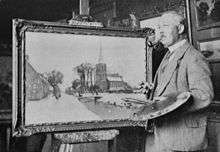
Life and work
He initially worked with his father as a decorative painter. Subsequently, he attended the School of Arts and Crafts. Then he continued his education, especially in the panel painting.
Van Beek has been active in various places in northern Holland. At first he was in Katwijk aan Zee until 1907, then he had a studio in Amsterdam. From 1911, he went to Kortenhoef (Wijdemeren), where he remained until 1931. Finally, his wandering ended in Vreeland (Stichtse Vecht), where he worked as a painter until his death in the year 1941 at the age of 66 years.
In Kortenhoef, he met Paul Gabriël, who had the major influence on his early work.[5] He brought him up to new issues such as the water lily landscapes in the polder area[6] and the issue of peat.
There he met Evert Pieters[7] and Jan Hillebrand Wijsmuller.[8][9] These teachers of the Hague School had a significant influence on his painting style and the perfection of his training.[10]
On his palette, he chose consciously always those mediums which produced a strong surface light. This followed the tradition of the Hague School 2nd generation. Even the winter face has not the usual darkness. Its luminosity is expressed with selected colours quality combined with the wet into wet technique with loose, fluid brushwork. This is a result of the surface of the canvas and the pigments with its binder.[11] In the paintings of the city face he orientated almost towards to Jan Vermeer (1632-1675), like "The street of Delft" and Gerrit Adriaensz. Berckheyde (1638-1698), like "Place at the St. Bravo Church in Haarlem". His chosen colors are a sensitive modification of the Hague School 2nd generation. Especially the selected, graded shade of blue as a message of the trapped atmosphere is a characteristic of him. The screen layout is corresponding to the former kind of the old Dutch landscape painting - he rises from bottom left to top right.[12] The horizon of his Pictures moves from the lower third, over the middle to upper third.[13]
His Œuvre
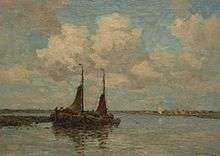
His chosen genres ranged from genre landscape painting with scenes of summer landscape, polders and the village face to the city face. In still life, he had primarily adopted the flower as an object.[14] He also chooses the classic theme of the windmill of Jan Hendrik Weissenbruch (1824-1903) and Paul Gabriel (1828-1903)—both are in the tradition of Jacob van Ruisdael (1630-1681). Very well known are the landscape paintings from the surrounding of Kortenhoef. He is primarily concerned with inland fishing themes, too.[15]
He also immortalized the old quarter of the township and followed the Amsterdam Impressionism, but he didn't follow their black period. In the 1920s, he discovered the bright, light village face. In the color palette, he follows Jan Vermeer and Gerrit Adriaensz. Berckheyde.
He belonged to the Kortenhoef School and the Hague School. He has been an amateur photographer, too.[16]
He became a member of Arti et Amicitiae.[17]
Van Beek died in 1941 at the age of 66 years.
Expositions
- 1903 Stedelijke internationale tentoonstelling van kunstwerken van levende meesters, Stedelijk Museum, Amsterdam.
- 1907 Stedelijke internationale tentoonstelling van kunstwerken van levende meesters, Stedelijk Museum, Amsterdam.
- 1912 Stedelijke internationale tentoonstelling van kunstwerken van levende meesters, Stedelijk Museum, Amsterdam.
Selected bibliography
Books
- Carole Denninger-Schreuder: De onvergankelijke kijk op Kortenhoef : een schilderdorp in beeld, uitgeverij Thoth Bussum, 1998, ISBN 90-6868-215-6, page 78 - 82.
Gallery
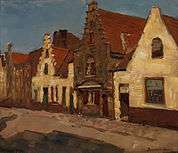 Street in Bruges (about 1910).
Street in Bruges (about 1910). House in the town (about 1920).
House in the town (about 1920).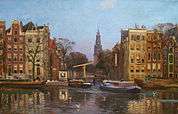 Voorburgwal (about 1920).
Voorburgwal (about 1920).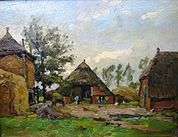 Farmhouse (about 1920).
Farmhouse (about 1920). Footbridge near Kortenhoef (about 1910).
Footbridge near Kortenhoef (about 1910). House near water (about 1920).
House near water (about 1920).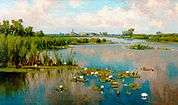 Water lilies near Kortenhoef (about 1920).
Water lilies near Kortenhoef (about 1920). Fishing boats near Kortenhoef (about 1920).
Fishing boats near Kortenhoef (about 1920).
References
- The Hague School in The Hague and its surroundings is the place of counterflow to neoclassical painting of the Netherlands and also the central place of origin of the Dutch movement of impressionism. It is also the dawn of the second golden age of Dutch painting.
- Art Historically van Beek of the flow of the 2nd Golden Age of Dutch painting attributed.
- The first Golden Age of Dutch painting in the 17th century was the time of the 7 republics of the Netherlands.
- "Bern van Beek". Olympedia. Retrieved 29 July 2020.
- Paul Joseph Constantin Gabriël (1828-1903) was one of the main representatives of the Hague School of the 1st generation. He became famous for his landscape paintings, namely scenes from the polder landscape with windmills and the rural idyll.
- At that time the water lily was an important theme in landscape painting, which was gladly taken up by many artists. These also include Constant Artz, Harold Gilmer, Claude Monet, Willem Roelofs, Gertrud Staats and Jan Hillebrand Wijsmuller.
- Evert Pieters (1856-1932) belonged to the 2nd generation of the Hague School. He had turned to the landscape painting and the genre around the daily life of the coast and countryside. The latter is in the tradition of the daily life of the farmers of Jan Steen (1625-1679) and the genre of Pieter Neuhys (1652-1679) of the 17th century and of Albert Neuhuys (1844-1914) of the Hague School of the 1st generation.
- See also Carole Denninger-Schreuder, page 78.
- Jan Hillebrand Wijsmuller (1855-1925) also was a member of the Hague School of the 2nd generation. Its genre included almost the entire œuvre of the movement of Dutch Impressionism.
- Here the ending system of the Barbizon school reflects once again, where the master and his pupil had a direct contact. In this way the education was to be continued.
- Here he leans on the tradition of the range of Jacob van Ruisdael, which in particular finds its precursor in the painting "Winter Landscape with Two Windmills" – (currently in private ownership.
- A good example for these lines from bottom left to top right rising horizon behind the peasant coach house is in the painting "Landscape with fountain" of Nicolaes Berchem (1620-1683) – formerly Gallery Lichtenstein.
- In the Dutch landscape painting of the 17th century usually the line of the lower third of the image horizon was dominating. The best example is "Evening landscape with a hamlet on the Maas Island" of Aert van der Neer (1603-1677) – it is to be seen in the Hermitage Museum in Saint Petersburg.
- The theme of still life has taken up by the Amsterdam Impressionism Quote page 4.
- It is in contrast to the paintings of Bomschuiten and the coastal fishermen of Noordwijk aan Zee, Katwijk aan Zee, Scheveningen and Egmond aan Zee.
- See also Carole Denninger-Schreuder, page 78.
- Bernard van Beek in the RKD
| Wikimedia Commons has media related to Bernard van Beek. |